Popups that Convert: How to Connect without Annoying Visitors
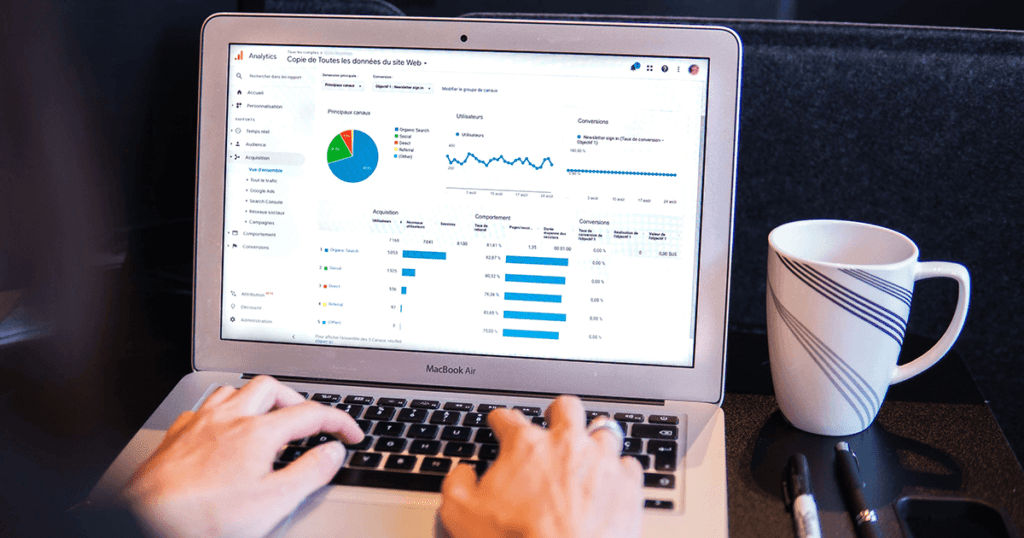
Let’s face it. Your site visitors spend more time on other websites than they spend on your website, and the number of modals, popups, slide-ins, sales banners, and GDPR cookie notices that your site visitors have to endure on their travels around the web can get a little out of hand. In some cases, a site owner’s desire for conversion forces a site visitor to endure multiple intrusive and disruptive distractions on a single page.
Common reactions from site visitors to popups, modals and overlays are often expressions of frustration, irritation, and annoyance.
The unfortunate reality is that popups, slide-ins, sales banners and other notices work. They demand that users pay attention, and they often achieve that goal. This is why site owners and marketers use them: to get short term boosts to conversion numbers. But often, they sacrifice our brand goodwill on the altar of conversion metrics.
At Kadence, we think there’s a better way.
After our recent launch of Kadence Conversions, we’re looking at how to implement these attention grabbing elements so that users connect positively with your brand without the irritation they’ve inherited from less effective implementations on other sites.
Why Do People Visit Your Site?
People arrive on your website for a purpose: to help them learn something, be entertained, to solve a problem, or achieve a goal.
They’re not there to “convert.”
Unless, of course, your idea of conversion is to give them exactly what they came to achieve: to solve their problems and achieve their goals in a way that builds a long-term relationship with your audience.
If you’re only considering what your conversion desire is — whether that is to get newsletter subscriptions or sales — your conversion goals are out of alignment with your customers goals.
To be better marketers and successful site owners, our conversion goals should align with what our customers are trying to achieve when they’re visiting our sites.
Redefining Conversion
Maybe that’s what we need. And maybe this is where Kadence Conversions can help us all become better online marketers. Let’s redefine what a conversion actually is.
For stellar marketers, a conversion is giving your audience what they came for in a measurable way. This means helping our audiences solve problems or learn something new. It means inspiring them, entertaining them and helping them achieve goals and to do all of this in measurable ways.
By changing the framework somewhat of what a conversion actually is, perhaps we can create better experiences.
Knowing Your Audience
In order to fully give our audience what they’re coming for, we’re going to have to know our audience. We need to know what motivates them, what their pain points are, what they’re trying to achieve, and if we’re really good, we understand what they need when they often say they want something else.
For example, in the early days of the iPhone without a keyboard, most users said that they wanted to keep their Blackberry keyboards. Innovative product creators like those at Apple knew there was a better way and that changed everything.
How do we get to know our audience? There are a few ways. HubSpot recommends:
- Review any current data and analytics.
- Look to previous successes among your audience.
- Create buyer personas.
- Conduct surveys.
- Keep an eye on your competitors.
- Monitor audience feedback, comments, and engagements.
- Experiment with content and updates to your products and services.
If you want conversion, give your audience what they want
Once you understand your audience, visit pages on your site and think about the conversion experience they want on each page. Where can we find places to provide a win-win for both our customers and us as marketers on every page on our site?
How to create popups that convert
Keeping in mind that our audience has negative experiences with popups, modals, overlays, slide-ins, and other attention seeking design elements, we can create useful popups that help our customers get what they want and avoid annoying them in the process.
Let’s find a way to make our marketing more useful by connecting with our customers empathetically, meeting them where they are and giving them what they came looking for.
It’s all about timing
When a site visitor first arrives on your website, why are they there? Did they click a link in a social post? Perhaps they clicked a link on someone else’s site. Maybe they saw an advertisement on television, maybe they searched for something quite specific. In any event, they’re on your site for a reason.
Let users get what they came for. If they came for something that is contained within the content of your site, don’t interrupt them.
If you’re going to use a popup or slide-in, make sure you’re addressing why users are there and use popups contextually, timed for rewarding them for specific action or providing a bonus relevant benefit after consuming content.
Did the user just read over 60% of an important blog post? Then maybe that means they’re ready to go deeper with more advice on solving their problem or achieving their goals with a special offer.
Luckily, Kadence Conversions lets you set the optimal time to show your popup, slide-in or banner. We’ll show you where to find those settings further down this page. But first, let’s look at some examples of other implementations of popups, modals, banners, and slide-ins to see what works, and what doesn’t.
Timing and value propositions that work
Our friends at WPMayor.com showed us an exit-intent popup with a clear value proposition. They don’t show the popup before we’ve read content and interacted on the site, but as soon as it looks like we’re ready to leave, this popup appears. They explain the benefits of their newsletter. They make sure that before you leave their site, you’re well aware of how to stay in touch in a valuable way. They also let you know who they are. People connect with people, and those personal brands elevate their site’s brand. They also let you know exactly what to expect from their newsletter: a single weekly newsletter that thousands of others receive and very few unsubscribe from. This is a great example of a well-timed, value proposing popup.
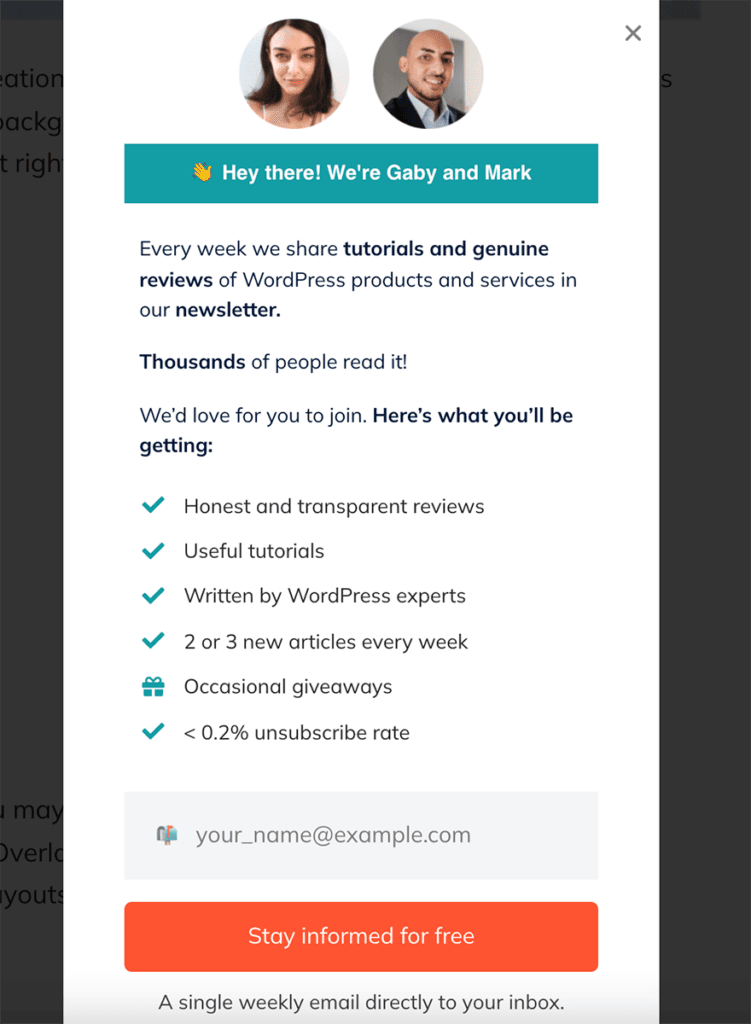
Making popups fun again
Lush has some fun with their popup, adding value of some well-timed playful comedy. People love to laugh, and they love brands with a sense of humor. Share your own and let your site visitors know that you don’t take yourself too seriously. Think about where can you have more fun on your site and experiment with it.
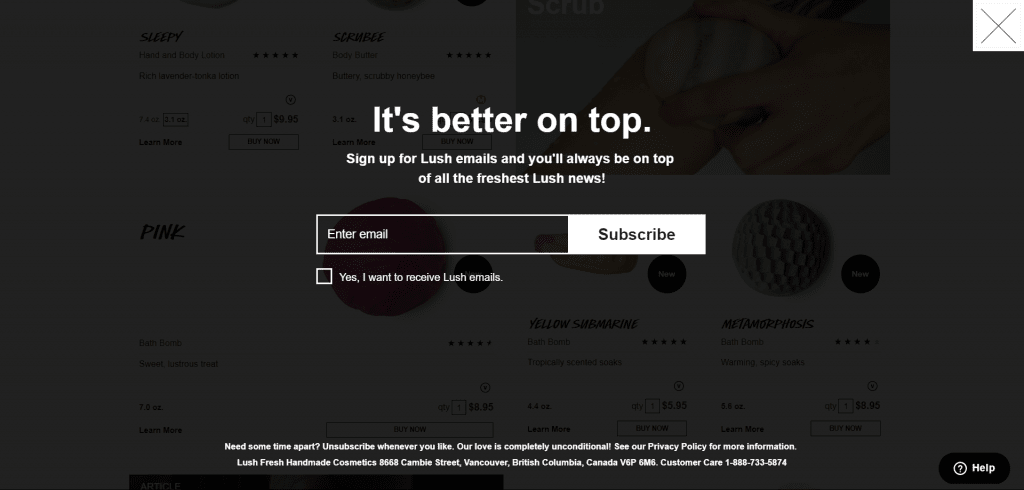
Giving users some time to browse products before popping up
Casper’s well-timed popup let’s us know that the products we’re reviewing are on sale as a part of their Black Friday sale. We didn’t see this popup until after quite a few minutes on their site. They wait until the site visitor has browsed products before they show the popup. This well-timed delay showed up after we were distracted by something else and stopped browsing.
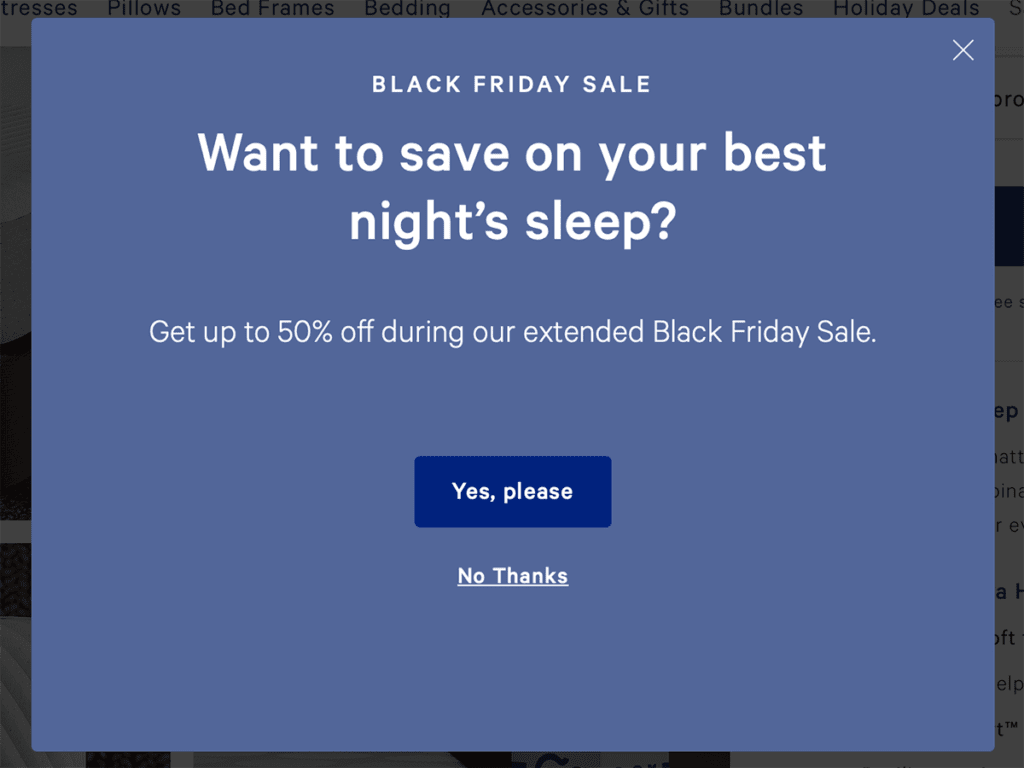
Personalized benefits for interacting, plus non-obtrusive appeals
HubSpot activated a slide-in on the lower right while we browsed content. The slide-in does not appear right away, appearing after we consumed quite a bit of content on the page. Then, the slide in comes in without obscuring any of the content. It stayed as long as we were on the page, with an option to dismiss.
Note that the slide-in contains an offer relevant to the content a user is reading, meeting the site browser where they are at in a more personal way. The offer engages the user deeper. If we want the free marketing plan and strategy template, we’ve got to provide a name and email (and often some other identifying information) so that the email marketing automations can do their job to nurture a deeper, more personalized relationship in the email inbox.
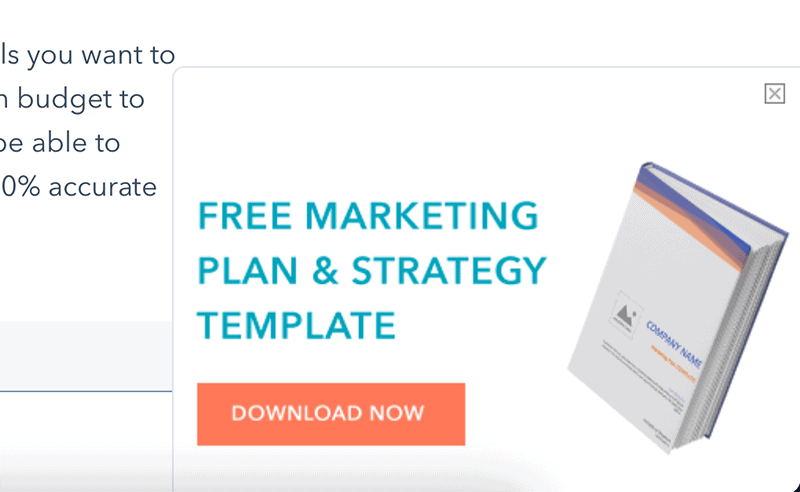
Ill-timed popups that don’t work
We were surprised to find so many large brands using popups that obscure content immediately on arrival. Note that many of the experts in usability in the eCommerce field such as Amazon and others don’t create conversion popups. (If you’ve seen one, let us know! We tried many common tricks to get Amazon to trigger one with no success.) What do they know that we might not?
We did get a few from some larger brands. Here’s what we found.
Williams Sonoma wants us on their list. So much so that when we did a search for a Williams Sonoma bread machine on Google, this is the first thing we saw, even before seeing what we were searching for. To get what we wanted, we had to first close the modal. A better timed popup would have allowed us to see the product first.
Using a fresh browser session, we saw this same modal on the home page. It appears that no matter how we show up on their site, they just really want to be in our inbox.
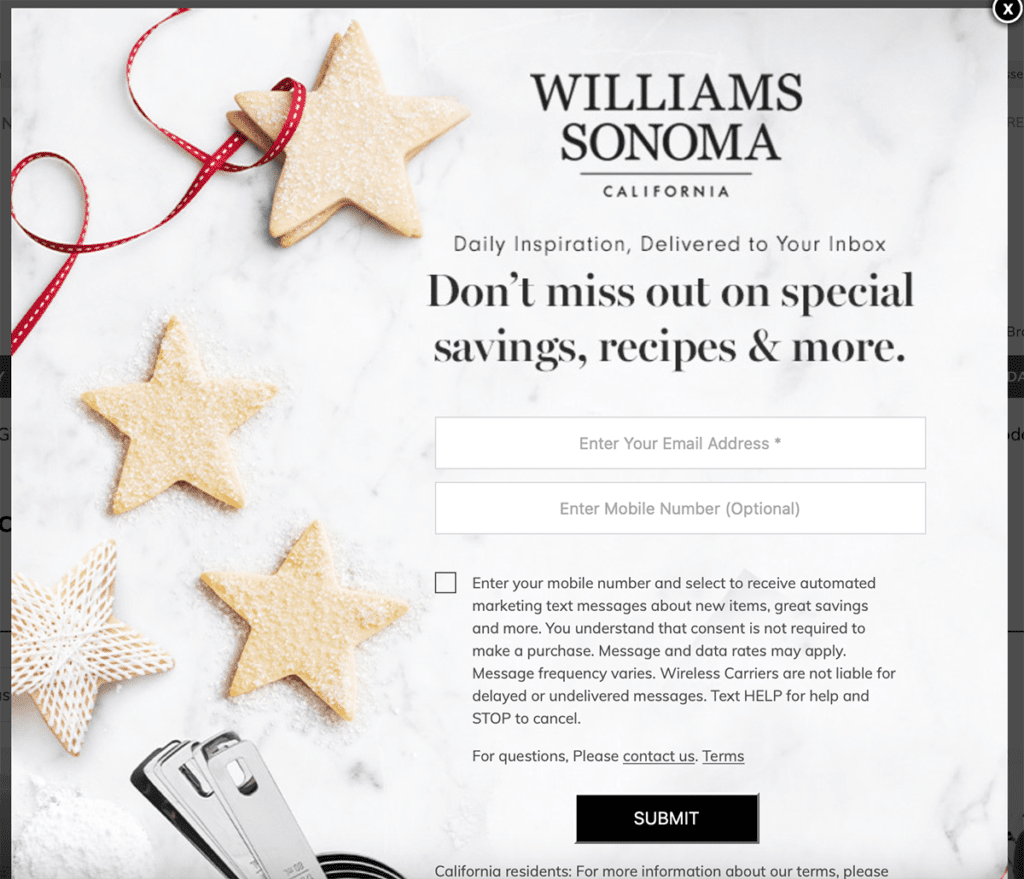
Williams Sonoma is not alone. We found numerous other brands doing the same immediate popup appeal. We believe that there are more creative ways to do popups, and we hope some larger brands can begin to choose solutions that better meet users where they are to make the web a better place.
Nice cookies, though.
Banners for non-obtrusive marketing alerts
Our friends at WPCrafter.com used Kadence Conversions for this Black Friday appeal. A banner across the top of the site links to a collection of Black Friday deals. No content is obscured, but the appeal is still quite noticeable above the main navigation. Users can still navigate to whatever they’re looking for, with an added benefit of navigating where they’d like to go. Unlike other banner plugins, Kadence Conversions ensures that your content is not obscured for the greatest usability.

Creating your popups, slide-ins, and banners
Kadence Conversions has everything you need to start creating these attention grabbing appeals on your site. And it’s pretty easy to start timing things so that your users aren’t interrupted or annoyed. Settings within Kadence Conversions will help you design a conversion experience specific to where your audience is on their conversion journey. Here’s where to find those settings and some thoughts on how to use them.
Launch Triggers
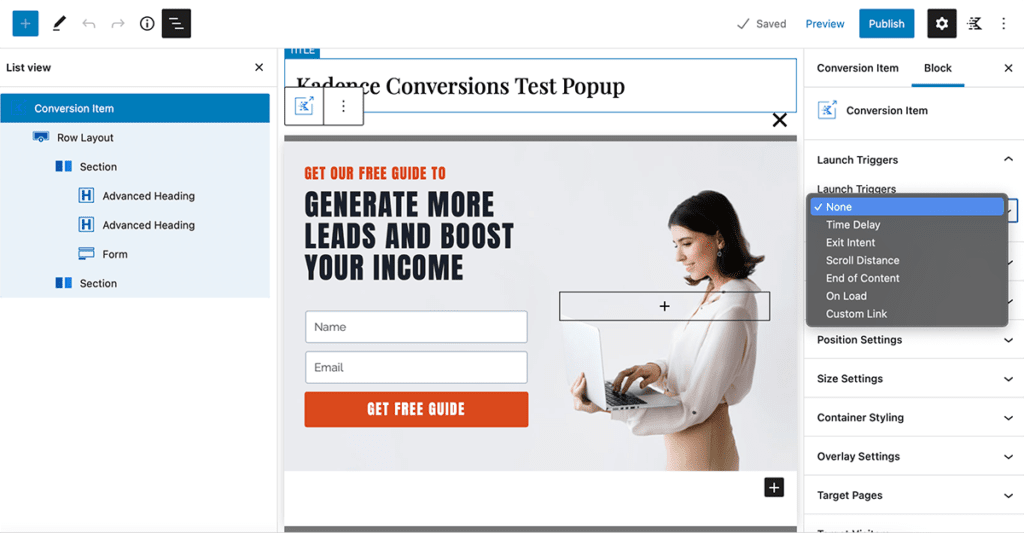
Target Pages
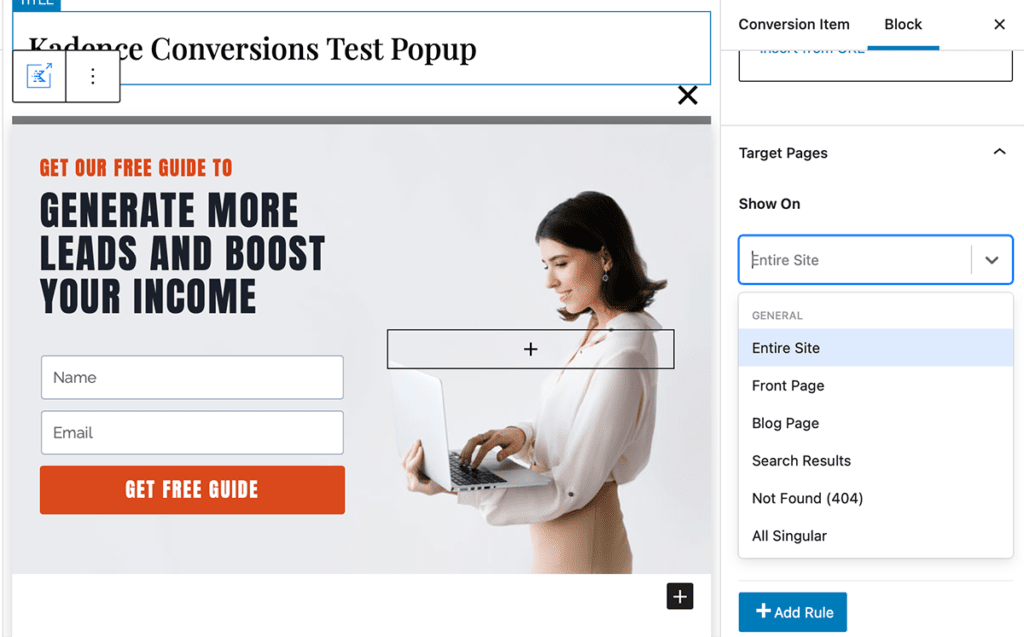
Repeat Control
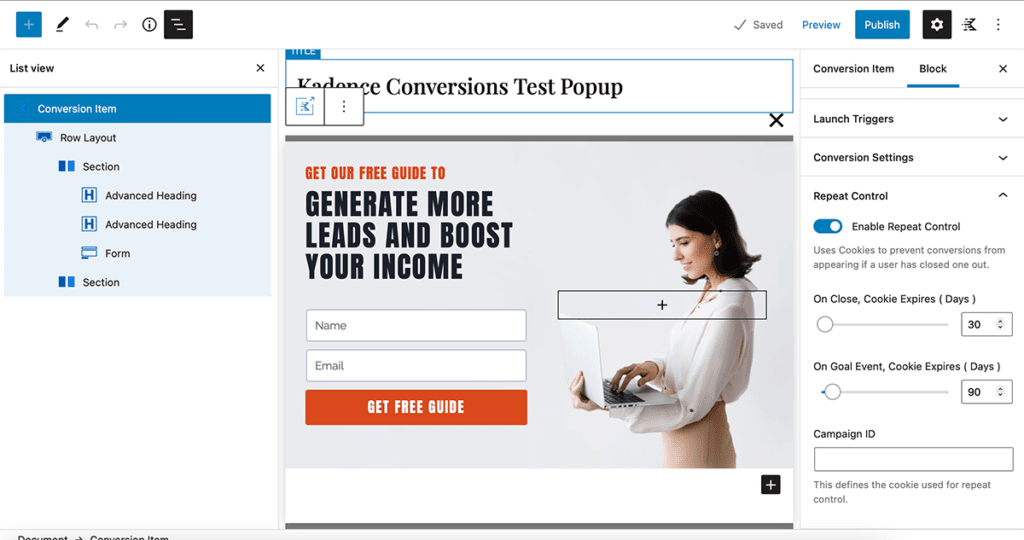
Target Requests
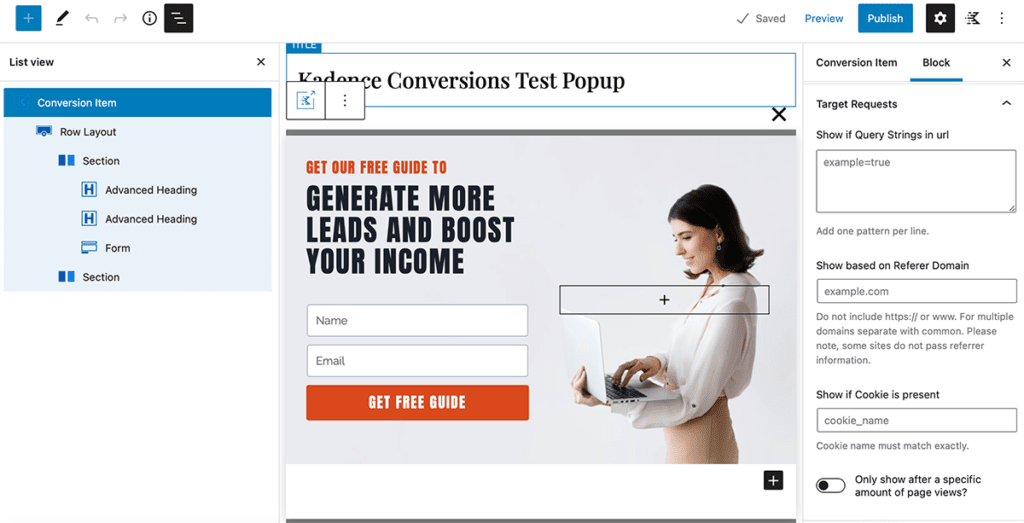
How will you use Kadence Conversions?
With all of these considerations combined with the capabilities in Kadence Conversions, you have everything you need to create meaningful experiences for your audience.
It really is up to you.
You can create popups, slide-ins, or banners that annoy, or you can make meaningful decisions to use these tools to craft unique, personalized, and effective conversion opportunities that make logical sense and have fun with users.
When we think about what our customers are trying to achieve on our site, we can better create marketing and content that create conversion experiences that meet our audiences’ real needs rather than just a short-term bump to our metrics.
These longer-term, customer-focused methods of building an audience will best serve our overall brand. This makes marketing to our audiences easier.
And, of course, Kadence is honored to be a part of the journey. Have you tried Kadence Conversions? What’s worked well for you? Let us know in the comments below.
Create Your Website With KadenceWP Today!
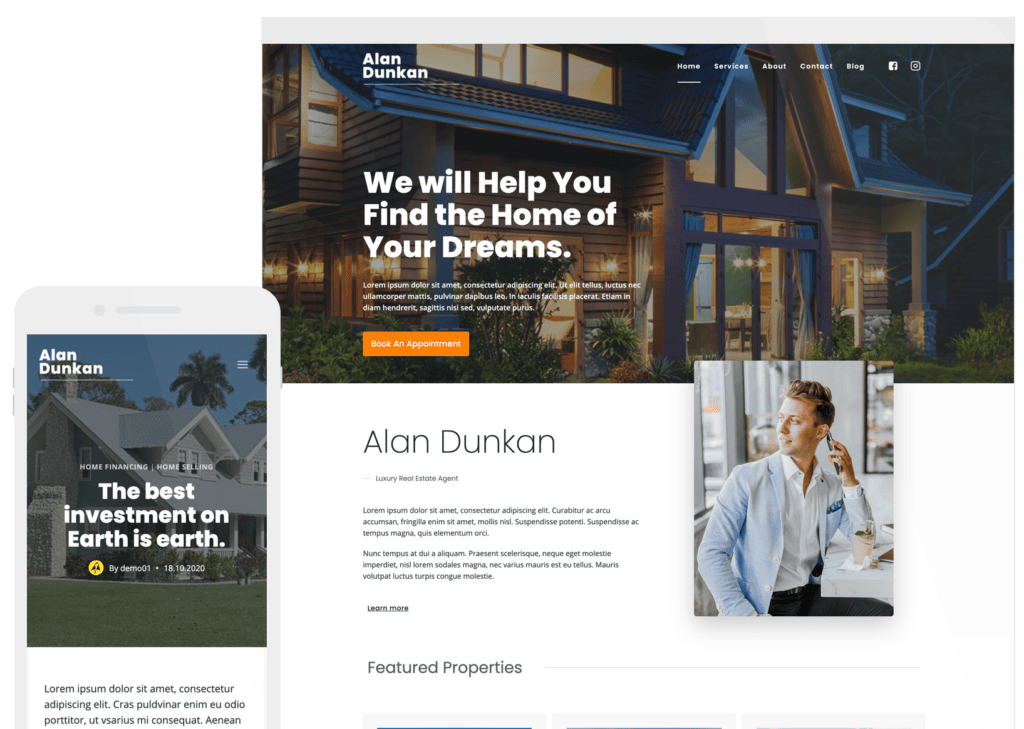
Written by Kathy Zant
Kathy is a writer and speaker who helps businesses and people thrive. She creates some of the best content and tutorials about how to get more out of technology, marketing how-tos that help you grow your business, reports on security issues you need to know as they occur, and gives you all the tutorials to stay ahead and secure your life and business.
3 responses to “Popups that Convert: How to Connect without Annoying Visitors”
Where do emails go once someone fills out the form?
It depends on how you’ve got your form set up. If you look at the form block within your Conversion, you can see a number of options under the Form Block settings under “Actions After Submit.” Ideally, adding it to your mailing list with a workflow or sequence could create an automation that automatically fulfills your conversion lead magnet, if that’s what you’re doing. Please do reach out to support with your goals for your conversion and our team would be happy to advise on specific settings to get what you need.
By Kathy Zant
Kathy is a writer and speaker who helps businesses and people thrive. She creates some of the best content and tutorials about how to get more out of technology, marketing how-tos that help you grow your business, reports on security issues you need to know as they occur, and gives you all the tutorials to stay ahead and secure your life and business.
Updated July 22, 2024

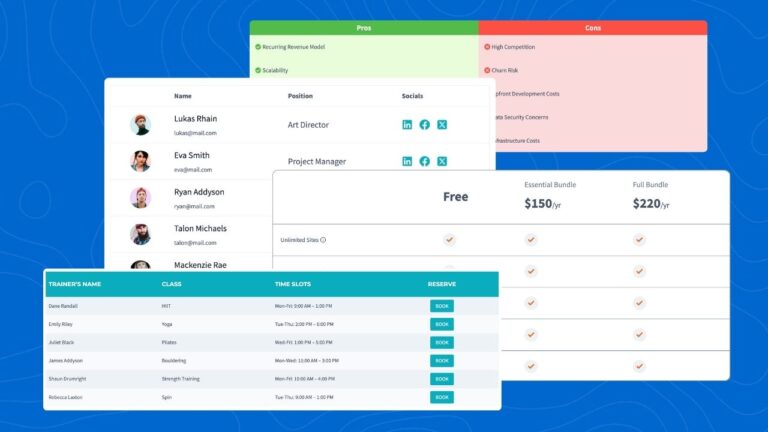

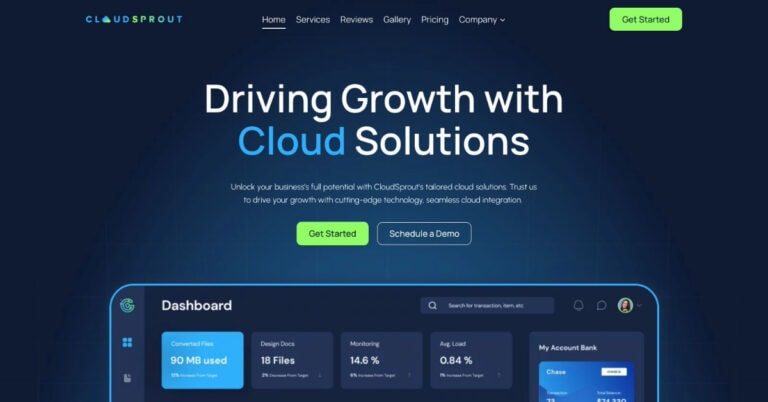
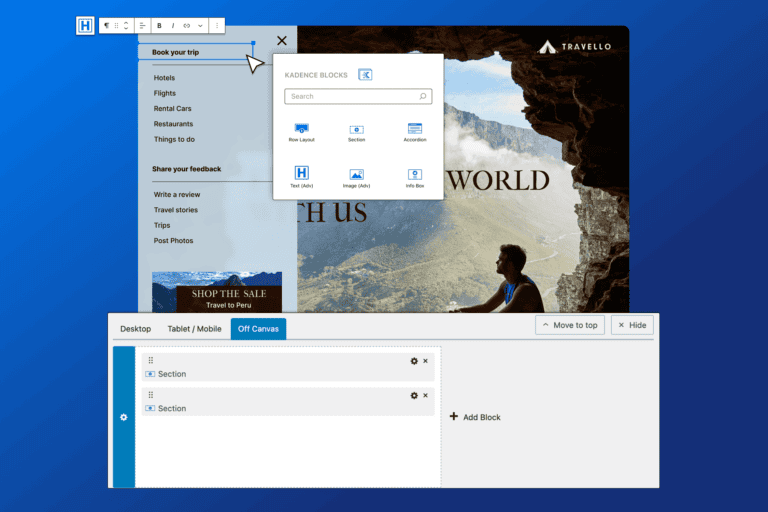
Buena descripción! gracias